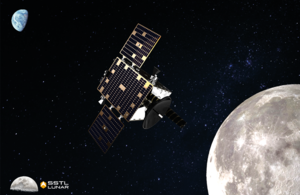Lunar Pathfinder
Lunar Pathfinder will be the world’s first dedicated lunar communications relay spacecraft when it launches in 2026.

Lunar Pathfinder is a single spacecraft designed by Surrey Satellite Technology Ltd (SSTL) that will offer commercial communication services to lunar orbiters and surface assets such as rovers and instruments, as well as a lunar navigation services demonstrator and scientific experiments.
The Lunar Pathfinder mission will support the booming demand from Lunar missions and serve the scientific community’s detailed study and analysis of the far side of the Moon, thus laying the foundation to support future sustainable science and exploration.

Polar Surface Data Relay
For polar surface assets, potentially with limited direct to Earth visibility, the use of Lunar Pathfinder’s data-relay service provides the assurance of a communication link, whatever obstacle the terrain may put between the asset and the Earth. Rovers, constrained to remain within line of sight of the lander to relay their communication, will find a new independence, both in how far they can go from the lander and how long they can survive beyond the lander’s limited lifetime.
For all lunar missions, including orbiters and near side surface assets, which could manage with direct to Earth communication, there is an additional economical and technical benefit to using the proximity data-relay service. Due to the proximity of the Lunar Pathfinder spacecraft, user assets could achieve higher data-rates with a lower performance, lower mass and lower cost communication module on-board.
Far side Lunar Exploration
The far side of the Moon, particularly the South Pole Aitkin Basin, is a key area for future robotic and human exploration due to its chemical and mineral composition. For surface assets on the far side of the Moon which operate without line of sight to Earth, Lunar Pathfinder’s communications relay service will be a mission enabler, providing the vital bridge between Earth and the lunar surface. The stable elliptical orbit of Lunar Pathfinder will allow for long duration visibility of the Southern Lunar Hemisphere each day, with maximum opportunities for the transmission and reception of data between Earth and the lunar surface.
Lunar Pathfinder Customers
Enabled by the UK subscription to the European Space Agency’s (ESA) exploration programme, ESA announced in December 2021 that it will be the anchor customer for services from Lunar Pathfinder. The agreement establishes ESA’s first commercial lunar services contract to deliver new opportunities for lower cost lunar science, technology demonstration and exploration missions. In addition, ESA is working with NASA on an agreement by which NASA would launch and deliver the Lunar Pathfinder spacecraft into its operational lunar orbit in exchange for data-relay services for their own missions, making NASA one of the first users of Lunar Pathfinder services.
Additional customers for services from Lunar Pathfinder are invited to calculate the service they could receive via SSTL’s Lunar Mission Builder App.
Lunar Pathfinder Experimental Payloads
As well as offering communication services to orbiters and lunar surface assets, Lunar Pathfinder will host a number of navigation and scientific experiments including:
- an ESA GNSS receiver, funded by the UK Space Agency and built by UK company European Engineering and Consultancy, capable of detecting weak signals coming from the Earth GNSS infrastructure (GPS and Galileo), demonstrating its potential role into lunar navigation services
- a NASA retro-reflector to demonstrate laser ranging capabilities
- an ESA radiation monitor to study orbital radiation conditions

Key facts
Some key facts about the mission include:
- Lunar Pathfinder spacecraft is being built by SSTL and is due for launch in 2026. It will be operated by SSTL from its Spacecraft Operations Centre in Guildford.
- Lunar Pathfinder will operate in an Elliptical Lunar Frozen Orbit (ELFO) for an operational lifetime of 8 years.
- Lunar Pathfinder will operate two simultaneous channels of communication with lunar assets, one in S-band and one in UHF: communications are relayed back to Earth ground stations in X-band.
- Phase A/B1 Moonlight study is being delivered by a consortium of experienced European space companies led by SSTL. The consortium includes SES Techcom, Airbus, GMV-NSL, Kongsberg Satellite Services and Goonhilly Earth Station.
How is the UK involved?
Lunar Pathfinder is supported by UK Space Agency funding via the European Space Agency.
The Lunar Pathfinder spacecraft is being built by Surrey Satellite Technology Ltd at the company’s facility in Guildford, as well as a number of sub-systems including an in-house S-band antenna.
UK company QinetiQ is using its heritage experience of Mars communication to design and build the Moon-link payload for the Lunar Pathfinder spacecraft. QinetiQ is working on the development of user terminals specifically designed units for compatibility to the Lunar Pathfinder service, for future users to plug and play.
On the ground segment side, Lunar Pathfinder will use the services of Goonhilly Earth Station deep space antenna in Cornwall, refurbished since the Apollo years and at the heart of the sustainable return to the Moon.
The Moonlight Phase A/B1 study is supported by the UK Space Agency across two competitive consortia, including UK companies SSTL, Airbus, Goonhilly Earth Station, GMV-NSL, KBR, Inmarsat and MDA UK. The implementation phase will be subject to future ESA subscriptions and competitive tender following ESA processes.
Updates to this page
-
Updates made throughout the page, and changes made to page structure.
-
First published.